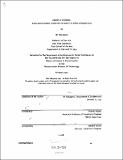Cinem-a-crobatic : trans-active cinema production in search of urban schizophrenia
Author(s)
Nakagawa, Iki
DownloadFull printable version (7.433Mb)
Alternative title
Trans-active cinema production in search of urban schizophrenia
Other Contributors
Massachusetts Institute of Technology. Dept. of Architecture.
Advisor
Dennis Adams.
Terms of use
Metadata
Show full item recordAbstract
On December 15, 1996, from 1:30 to 4:30, cinem-a-crobatic was formally presented at Columbus Park, New York City. The park is located at the intersection of China town and the Federal Court district. cinem-a-crobatic attempts to amplify the complex and shifting relationship between the urban landscape and the experience of its inhabitants, through the introduction of a new form of urban cinema production. Unlike most conventional cinematic productions, cinem-a-crobatic is a cinema-production-like "play." Its participants are the production crew and the public who interact with the crew at the site of production. The production crew consists of a director, a camera person and actors. I have also included a person who interviews the director and actors to question their motives behind each scene. The roles of the production crew are interchanged among the participants. cinem-a-crobatic not only stimulates new possibilities of cinematic story tel ling by integrating the realities of urban life as a structural basis for its narrative construction, it also attempts to serve as a new method for generating social interaction. Central to the production of cinem-a-crobatic was the use of a new video device that was specifically developed for the project . It was mounted on a standard film dolly and functioned as a nomadic instrument which was pushed around the park by the participants. It functioned both as a sculptural matrix for the production and as a visual lure for drawing the public into its performative arena. This device recorded, edited, and projected the captured video image on the surface of a transparent glass screen that simultaneously framed the real landscape. This thesis text is in two parts. The first part describes the project in detail, including a brief history of how the project evolved, who the participants were, and the nature and use of the video device. The second part discusses the autobiographical and philosophical framework for the project.
Description
Thesis (M.S.V.S.)--Massachusetts Institute of Technology, Dept. of Architecture, 1997. Includes bibliographical references (p. 42-45).
Date issued
1997Department
Massachusetts Institute of Technology. Department of ArchitecturePublisher
Massachusetts Institute of Technology
Keywords
Architecture.